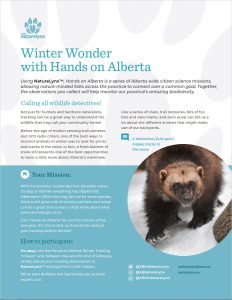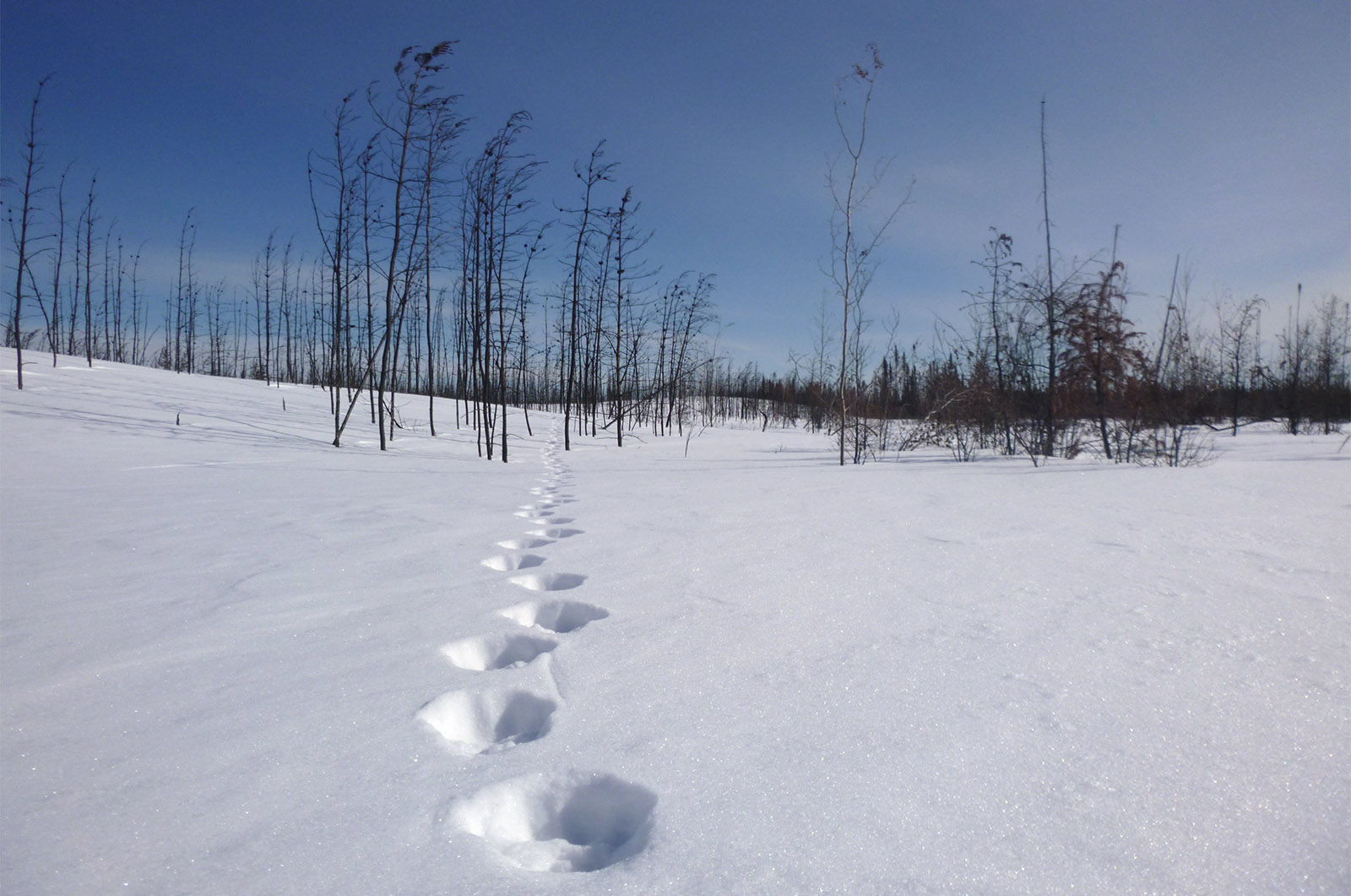Calling all wildlife detectives!
With the frigid weather we’ve been having, you might think that most of Alberta’s critters would be hibernating. While this is true for some species, many stay active right through the deep freeze, going about their business just fine—all without the aid of down parkas, Sorel boots, or hot-pockets. Winter is actually a great time to learn more about what some animals are up to, and we’d like your help.
Join “Hands on Alberta” for our first mission of the new year. Grab your parka, boots, and hot-pockets and put your tracking skills to the test!
The backstory:
Using the ABMI’s NatureLynx app as a platform, Hands-on Alberta is a series of Alberta-wide citizen science missions that encourages nature-minded folks across the province to connect over a common goal. Over time, we hope that the observations collected through Hands-on Alberta missions will help monitor our province’s amazing biodiversity. We’ll need a lot of samples to be able to draw reliable scientific conclusions from this information, so consider this a first step for now. In the meantime, we hope they’re a fun excuse to get outside and get to know Alberta’s wildlife.
The mission (should you choose to accept it):
Tracking isn’t just for hardcore naturalists and hunters. It’s a great way for anyone to get outside, shake off the frost, and get to know the wildlife that calls their community home.
Before motion-sensing trail cameras and GPS radio collars became common in wildlife monitoring, one of the best ways to understand what animals do in winter was to look for prints and tracks in the snow. Even today, a fresh blanket of snow presents a unique opportunity to learn more about some species—especially Alberta’s mammals—that are hard to monitor ‘in the flesh’. And with all the snow we’ve been having, this winter is a wildlife detective’s dream.
Winter tracks and sign are like a series of clues: trail networks, bits of fur, bite and claw marks, and even poop can tell us a lot about the different animals that might make use of our backyards. In this mission, we’re looking for any of these signs of wildlife.
How to participate:

We even made brochures so you know this is serious! View the full brochure here.
It’s easy! First, make sure you have the free NatureLynx app installed (Android, iPhone), or else access the NatureLynx website. Next, join the Hands-on Alberta: Winter Tracking “mission” and, between now and the end of February, simply upload your tracking observations (footprints, fur, scratch-marks, poop…) to NatureLynx and tag them to the hands-on Alberta mission. If you think you know what species your observations are from, you can suggest an ID and NatureLynx’s team of wildlife experts will help confirm it. Or, if you’re not sure what you’ve found, our experts are there to provide an answer.
Here are a few tips to help get you started on the mission:
Scale is important
Bigfoot or toddler? When snapping a photo of a print, try to include some type of scale for reference. This can be a ruler, or anything of a known size (e.g., a pencil, pocket knife, compass, water bottle, your hands, a banana…). Without a reference for scale, it can be difficult to tell the exact size of the print, and that can make it difficult to identify what kind of animal made the tracks.

The prints of a Snowshoe Hare. Note that the snowshoe-shaped rear footprints (left) are actually ahead of the smaller front footprints. (But remember: if possible, try to include some kind of scale reference in your photos!) (Credit: David Evans)
It’s not just about the print in front of you
Individual prints can tell us a lot about an animal, but it’s important to look for the pattern between these prints, too. This pattern, or gait, can be one of the best ways to ID tracks in the snow. For example, weasels will hop, leaving pairs of prints, while coyotes and foxes typically put one paw in front of the other leaving a straight and narrow track in the snow. Because they propel themselves with their huge back feet, snowshoe hare tracks actually have the large hind footprints ahead of the smaller front footprints, leading to a characteristic Y-shaped grouping of prints.
When to track?
The best time to track is right after a light (5–10 cm) snowfall. Fresh snowfall is a blank canvas, making it easier to spot new prints. But if the snow is too deep, it can make things more difficult as snow can collapse on top of the track, distorting the prints. Plus, you’ll need higher boots. And more hot-pockets.
Have fun!
Sometimes it’s hard to work up the energy to go outside in the cold, but we know you have what it takes to be a great winter wildlife detective. Bundle up, find a friend, take a thermos of something warm, and explore Alberta’s winter wildlife wonderland!
To learn more about Hands-on Alberta and other NatureLynx-related programs, contact the ABMI’s Citizen Science coordinator, Jordan Bell, at natlynx@ualberta.ca or visit naturelynx.ca.
Facebook: @ABNatureLynx
Twitter: @ABMINatureLynx
Instagram: ABMI.NatureLynx
This post was a joint effort between Jordan Bell and Kurt Illerbrun.


